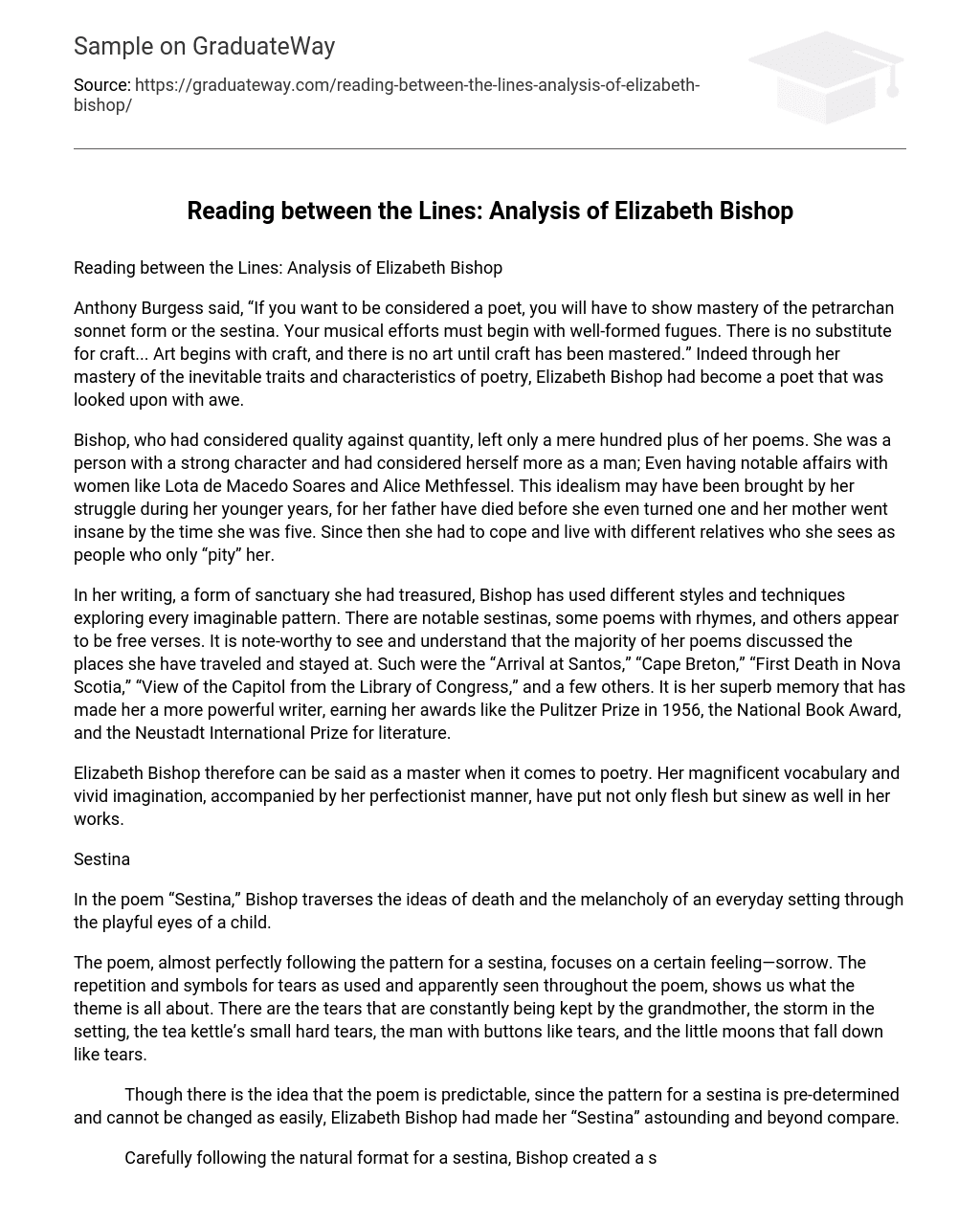Anthony Burgess said, “If you want to be considered a poet, you will have to show mastery of the petrarchan sonnet form or the sestina. Your musical efforts must begin with well-formed fugues. There is no substitute for craft… Art begins with craft, and there is no art until craft has been mastered.” Indeed through her mastery of the inevitable traits and characteristics of poetry, Elizabeth Bishop had become a poet that was looked upon with awe.
Bishop, who had considered quality against quantity, left only a mere hundred plus of her poems. She was a person with a strong character and had considered herself more as a man; Even having notable affairs with women like Lota de Macedo Soares and Alice Methfessel. This idealism may have been brought by her struggle during her younger years, for her father have died before she even turned one and her mother went insane by the time she was five. Since then she had to cope and live with different relatives who she sees as people who only “pity” her.
In her writing, a form of sanctuary she had treasured, Bishop has used different styles and techniques exploring every imaginable pattern. There are notable sestinas, some poems with rhymes, and others appear to be free verses. It is note-worthy to see and understand that the majority of her poems discussed the places she have traveled and stayed at. Such were the “Arrival at Santos,” “Cape Breton,” “First Death in Nova Scotia,” “View of the Capitol from the Library of Congress,” and a few others. It is her superb memory that has made her a more powerful writer, earning her awards like the Pulitzer Prize in 1956, the National Book Award, and the Neustadt International Prize for literature.
Elizabeth Bishop therefore can be said as a master when it comes to poetry. Her magnificent vocabulary and vivid imagination, accompanied by her perfectionist manner, have put not only flesh but sinew as well in her works.
Sestina
In the poem “Sestina,” Bishop traverses the ideas of death and the melancholy of an everyday setting through the playful eyes of a child.
The poem, almost perfectly following the pattern for a sestina, focuses on a certain feeling—sorrow. The repetition and symbols for tears as used and apparently seen throughout the poem, shows us what the theme is all about. There are the tears that are constantly being kept by the grandmother, the storm in the setting, the tea kettle’s small hard tears, the man with buttons like tears, and the little moons that fall down like tears.
Though there is the idea that the poem is predictable, since the pattern for a sestina is pre-determined and cannot be changed as easily, Elizabeth Bishop had made her “Sestina” astounding and beyond compare.
Carefully following the natural format for a sestina, Bishop created a setting that depicts a normal day with a brewing storm. It is to quote that the poem showed a sequence. A sequence wherein there is a rearrangement of words. Though it might be plainly explained by the pattern used by the poet, the title itself seems to convey something else. And since the center of the poem is a child, it might be said that the format of the poem, a sestina, is used to reason out how the child views what is happening around him; rearranging everything until at last it all makes sense.
In “Sestina,” comprising of seven stanzas, each with six lines except for the last stanza with only three, it is noticeable that Elizabeth Bishop didn’t followed the last requirement of the pattern she used. Supposedly, the last stanza should have the six words, exactly how she have used them in the first stanza. However, Bishop made it different. Instead of “house, grandmother, child, stove, almanac tears,” she wrote “tears, almanac, grandmother, stove, child, house.”





